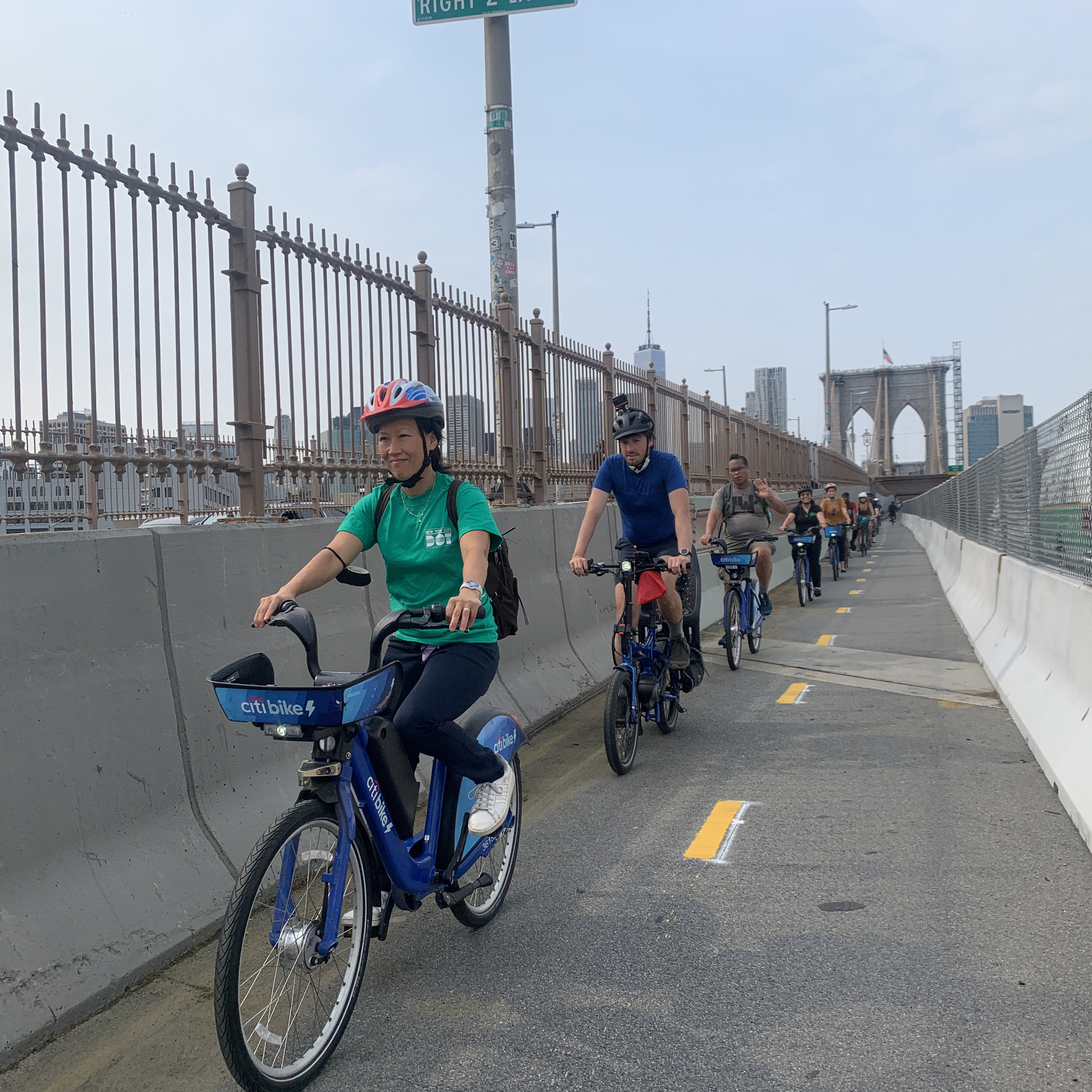 Cyclists enjoying the new Brooklyn Bridge bike lane, showcasing the significant increase in bicycle traffic after the dedicated path was opened in New York City. The image highlights the success of repurposing car space for bike infrastructure.
Cyclists enjoying the new Brooklyn Bridge bike lane, showcasing the significant increase in bicycle traffic after the dedicated path was opened in New York City. The image highlights the success of repurposing car space for bike infrastructure.
New York City’s iconic Brooklyn Bridge is witnessing a cycling surge, thanks to the newly established, dedicated Brooklyn Bridge Bike Lane. Since its opening, the number of cyclists using the bridge has skyrocketed, demonstrating the powerful impact of prioritizing bike infrastructure in urban environments. Recent data reveals an astonishing 88 percent increase in cycling trips this October compared to the previous year, signaling a major victory for bike advocates and a significant shift in how New Yorkers are navigating their city.
Bike Lane Success: The Numbers Speak Volumes
The transformation of a former car lane into an eight-foot wide, two-way brooklyn bridge bike lane on the Manhattan-bound side of the bridge occurred on September 14th. The immediate impact was undeniable. In September alone, average daily bike trips jumped to 3,635, a substantial 56 percent increase from the 2,336 trips recorded in the same month last year. Compared to the pre-pandemic levels of 2019, the increase is nearly 37 percent.
October’s figures further amplified this success story. An average of 4,206 daily trips were recorded, an impressive 88 percent leap from the 2,239 trips in October 2020, and almost 69 percent higher than the 2,492 trips in October 2019. This dramatic surge in usage firmly establishes the brooklyn bridge bike lane as a highly popular and effective piece of cycling infrastructure.
Interestingly, this bike boom on the Brooklyn Bridge is not mirrored across all East River crossings. Ridership on the Manhattan Bridge and other city-owned spans has remained consistent with historical trends, highlighting the unique draw and impact of the new brooklyn bridge bike lane.
Induced Demand: A Proven Principle for Cycling
The remarkable increase in cyclists on the Brooklyn Bridge serves as a real-world example of “induced demand.” This principle, often discussed in transportation planning, suggests that increasing the supply of infrastructure, in this case, bike lanes, directly leads to an increase in demand, or usage. The brooklyn bridge bike lane perfectly illustrates this concept, proving that when safe and convenient cycling infrastructure is provided, more people will choose to bike.
Advocates who championed the brooklyn bridge bike lane celebrate these numbers as a validation of their long-fought efforts. Liz Denys, a leading voice from Transportation Alternatives’ Bridges 4 People campaign, emphasized that “Prioritizing people over cars to build safe bike infrastructure works.” This success is seen as a stepping stone towards further expansion of bike-friendly infrastructure across the city’s bridges and roadways.
Looking Ahead: Expanding the Vision for Bike-Friendly Bridges
While the brooklyn bridge bike lane is undeniably a success, there’s acknowledgment that further improvements are needed. Although functional, the eight-foot width of the two-way path falls short of national guidelines, which recommend a minimum of 12 feet for such lanes. City officials have indicated they are exploring the possibility of adding a protected bike lane on the Brooklyn-bound side of the bridge, which would optimize the existing lane for westbound cyclists.
However, challenges extend beyond the bridge itself. Cyclists exiting the brooklyn bridge bike lane into Manhattan still face obstacles in navigating further north or west. While some protected bike lanes have been installed on connecting streets like Centre Street, they are often fragmented and fail to provide seamless connections to existing bike networks, such as those on Grand and Lafayette Streets, or westward towards the Hudson River Greenway. Addressing these connectivity issues is crucial to fully realize the potential of the brooklyn bridge bike lane and encourage wider cycling adoption.
Maintaining Success: Cleanliness and Continued Commitment
Despite its popularity, the new brooklyn bridge bike lane faces a persistent challenge: litter. Reports and images have emerged showing trash accumulating on the path, highlighting the need for consistent maintenance to ensure a pleasant and safe experience for cyclists. The city has pledged to address this issue, recognizing that cleanliness is vital for the long-term success and appeal of the infrastructure.
 Garbage accumulating on the new Brooklyn Bridge bike path, illustrating the challenge of maintaining cleanliness on popular cycling infrastructure in New York City despite increased usage.
Garbage accumulating on the new Brooklyn Bridge bike path, illustrating the challenge of maintaining cleanliness on popular cycling infrastructure in New York City despite increased usage.
The overwhelming success of the brooklyn bridge bike lane underscores the demand for and positive impact of dedicated cycling infrastructure. It serves as a compelling case study for urban planners and policymakers seeking to promote sustainable transportation and create bike-friendly cities. As New York City continues to grapple with traffic congestion and environmental concerns, the brooklyn bridge bike lane offers a glimpse into a future where prioritizing cyclists leads to a healthier, more accessible, and more sustainable urban environment for all.
